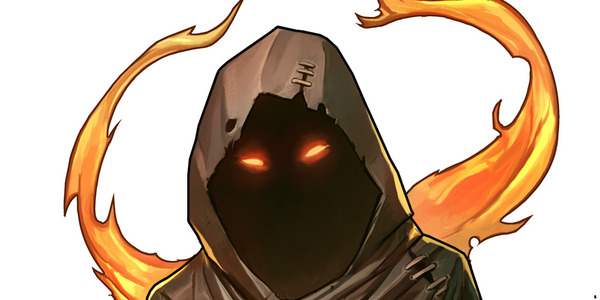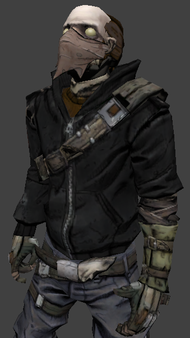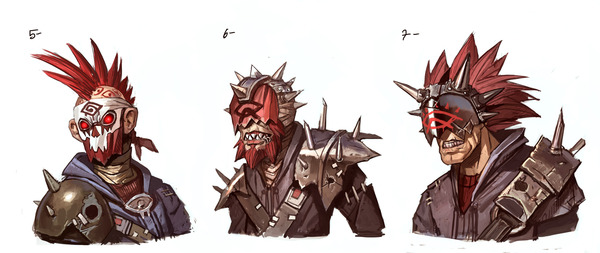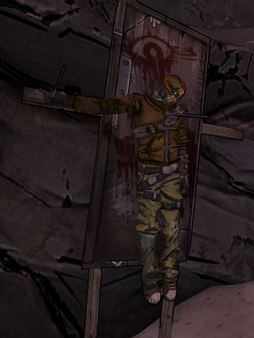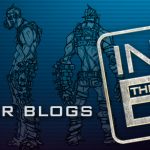Inside the Box serves as a forum for individuals involved in the production of Gearbox Software content to share personal motives, methods, process and results. Gearbox Software projects are created by a diverse range of individuals spanning a spectrum of different backgrounds, interests, objectives and world views. The views and opinions expressed in this article are those of the author and do not necessarily reflect the official policy or position of Gearbox Software or any of its individual members outside of the author.
Hello! I’m Keith Schuler, Senior Designer on Borderlands 2. Today, I want to talk through some of the design for one of the major plot missions, Hunting the Firehawk.
Big time spoiler alert, by the way. If you still haven’t played through this mission, I’m here to ruin all the surprises.
Hunting the Firehawk is an extremely important mission, from a narrative standpoint. Though the player has heard from Roland by now, he hasn’t met any of the original Vault Hunters in person yet, and has no idea of the degree to which those characters will be involved in this adventure. The story also needed to make sense both to new players and to fans of the first Borderlands, when the new players don’t even know who Lilith is.
So, how could we reintroduce our feisty Siren in a way that all players, both old and new, would enjoy?
Introducing The New Lilith
Anthony Burch (Lead Writer) rose to the challenge in a brilliant way. The Vault Hunters were virtually blank slates anyway, with only as much personality as could be conveyed through a few lines of battle dialog in the first game. Now that they were all major players in a huge narrative with distinct personalities. So, why not introduce Lilith as an entirely new character? Give her an unfamiliar name, a shadowy ECHO portrait, and process her voice so that she sounds like a ransom message. Spend the entire mission building up her reputation as a god to bandits and a ruthless murderer. Then, when her true identity is revealed, fans of the original Borderlands will have an a-ha moment, while new players will simply know her by the reputation and back story we’ve provided.
Wherefore Art Thou, Fink?
In the original draft of the mission, the Firehawk’s message said “This is the Firehawk. We must speak. This is not a request.” Scooter then came over the ECHO and sent the player to Moxxi, who in turn said that Fink would know where the Firehawk might be found. As luck would have it, Fink was in her establishment’s restroom right that second. When the player entered the restroom, Fink would escape out a window, and the objective would be to chase Fink around Sanctuary, catch him, and beat him up until he confessed the location of Firehawk’s lair.
You may recognize that name. Fink now runs the Bandit Circle of Slaughter in The Fridge, and the player never so much as touches him. So, what happened?
The Fink objective had a few problems. For one thing, it’s pretty hard to tell a player, in a game all about guns, to melee attack a character but don’t kill him. The objective required a lot of long winded explanation from Angel. “Okay! Beat him up! No, no, don’t shoot him! Stop shooting him! He’s not going to die because he’s a critical mission NPC but you still need to stop shooting him and punch him instead!” I think Anthony wrote it better than that, but you get the idea. It was clunky.
The final nail in Fink’s metaphorical coffin, though, was simply the amount of memory available to us in a single level. Sanctuary is expensive. There are a lot of unique character models in there, including the four original Vault Hunters, Marcus, Zed, Scooter, Moxxi, Sir Hammerlock, and Claptrap. Not to mention the two generic Sanctuary Citizen models. (Yes, two. One man and one woman. Any perceived variety comes from colorization, attachments, and bone-scaling their proportions. We could do a whole separate article on that.) Add to that the geometry and materials used for the environment, four players with all their inventory, and the asset requirements of an entire game’s worth of missions, and it all adds up to a whopping expensive level, memory-wise.
Fink, meanwhile, is a memory-intensive character model because he has the body of a Bandit Marauder and the head of a Rat. So, take a clunky mission objective that wasn’t working out, and add an expensive character to a level that’s taking up a fair amount of memory and it was an easy decision to bid the Fink objective “adieu.”
So how did we plug that gaping hole in our mission? It was simple. Anthony changed the Firehawk’s message to say “Come to Frostburn Canyon or people will die” and we set the first objective to be “Go to Frostburn Canyon.” The result is a much cleaner, easier to understand mission. This is just one of many examples where cutting content makes a better game. Have you ever heard Fink say something like “That’s for beating me up!” during the Bandit Circle of Slaughter? He’s talking about the objective we cut, but we accidentally left that line in the game.
Frostburn Canyon: Land of Confusion
Frostburn Canyon is beautiful, and it has a lot of great combat spaces, but it also has a regrettably confusing layout. Nate Overman, the Level Designer who built Frostburn Canyon, describes the level as a grand experiment. He wanted to see if we could get away from the standard open areas and linear levels with a branching fork in the middle. So, Frostburn Canyon was intended to be shaped more like a pretzel, with connections where the lanes intersected so that a player could jump from one path to the other.
When I started implementing Hunting The Firehawk in Frostburn Canyon, almost all work on the level was already done. The combat was fun, the level looked great, and Nate had moved on to other areas that desperately needed his attention. Unfortunately, once we started trying to make missions work in the space, it was obvious that having paths that crisscrossed each other and doubled back on themselves caused quite a bit of confusion, especially given how our simple 2D map worked. The space was already built, though, so it was on me, as the mission designer, to make the mission work.
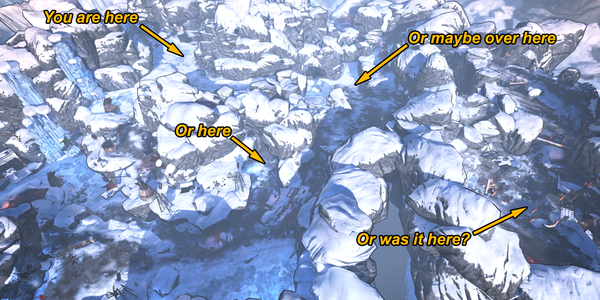
A bird’s eye view of Frostburn Canyon. The player enters the level at “Or here”.
The first thing I did was to set up the waypoints. In order to keep the player from getting lost, I set up a “trail of breadcrumbs”: nearly every waypoint could be reached by moving in a straight line from the previous waypoint. That way, the player was effectively playing “follow the waypoint” throughout the level and the risk of them getting off track and hopelessly lost was greatly reduced.
One problem a designer can run into with a breadcrumb trail of waypoints, though, is that the player can end up feeling like he’s “chasing wisps.” He touches a waypoint and it disappears, only to be replaced by another waypoint farther away, with no objective update. It’s an incredibly unsatisfying feeling, like we had promised a reward and then told the player “sorry, but your waypoint is in another castle.”
Fortunately, Anthony Burch likes to write. He wrote a ton of exposition for this mission. All of this exposition built up Lilith’s character, but by triggering a line of dialog each time a waypoint was reached, it provided the additional value of making something happen at each location. If the player reached a waypoint, then he was rewarded with a bit of silly dialog between Flanksteak and Angel, or a taunt from Handsome Jack. It’s not a lot, but it’s not nothing. With any luck, the player would not feel like he was chasing wisps.
The Bandit Clans Go To War
I still felt like it wasn’t enough, though. The waypoints led the player through the level, and the exposition provided the player with some entertainment, but it was still hard for the player to feel his progress. We also had a problem in that the player could clear a certain number of waypoints, then quit and come back later, and he would no longer have the convenient breadcrumb trail. Instead, he’d have a random waypoint sitting somewhere in the middle of the level, with no clue how to reach it.
At the same time, we were having a problem with one of the aspects of the story. Why did some of the bandits worship the Firehawk, while other bandits were trying to kill her? We eventually hit upon a solution: bandit clans. The story already talked about “Bloodshot” bandits in the dam level, and Brick surrounded himself with “Slab” bandits. Why not add another clan that lived in Frostburn Canyon and worshipped the Firehawk? Thus, the Incinerators were born.
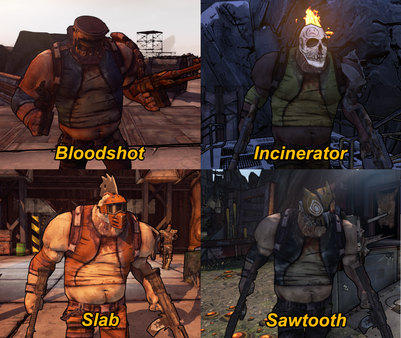
Goliaths of four different bandit clans.
Now Frostburn Canyon could have two separate bandit clans at war with one another. The Incinerators were the residents, while the Bloodshots were the invaders who had decided that the best way to beat their enemies was to kill the Firehawk. Anthony rewrote a bunch of lines to flavor the story this way, and it gave me some new ways to think about helping the player find their way through the level.
My first idea was to have bandit vs. bandit combat in each area that I wanted to lead the player towards. If the player generally followed the mayhem and the Bloodshots’ push through the level, then they would be able to find the path in a more interesting way than simply following a trail of waypoints.
I started to implement this idea. You can see just inside the entrance to Frostburn Canyon. As you walk past the vending machines, some bandits run across your path from left to right. This is actually two Bloodshots mowing down two Incinerators. I cheated and gave the Incinerators really low health so that they’re pretty much guaranteed to die while the player looks on. If the Bloodshots survive, they continue to run all the way down the hill, leading the player to the next waypoint (and getting wasted by the Incinerators down there while they’re at it.) Angel comments on how the two clans appear to be at war with one another.
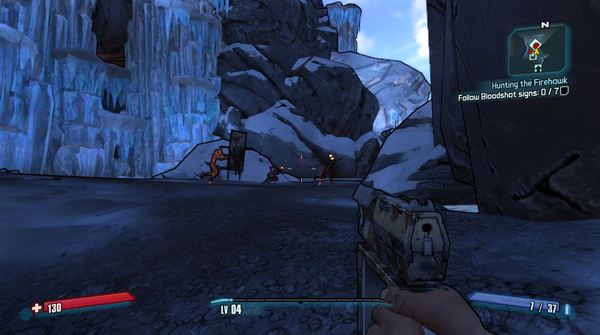
Who’s fighting whom, now?
I thought this was working fairly well, but Paul Hellquist (Creative Director) pointed out to me that the visual distinction between the bandit clans was probably too subtle for most players to pick up on. “Oh look, there’s crazy bandits being crazy and fighting each other”, they’d say.
Well, maybe the intro was a little weak, but I figured if I could get some fierce bandit vs. bandit combat going in some other parts of the level, then that would sell the idea better. Remember that this was fairly late in the project, though. When I approached our Lead Level Designer, Jason Reiss, with my idea, the look in his eyes simply said “I got 99 problems and your unproven bandit war ain’t one.” Well, that’s how I interpreted it, anyway. We had our Incinerators and our Bloodshots, but the combat was already solid in this level, and we weren’t going to muck it up by throwing extra bandits into the mix.
All Signs Point To The Firehawk
I had to think of something else that would help the player along, but wouldn’t place an unnecessary burden on the other departments. That’s when I tried to think like a Bloodshot. If this was unfamiliar territory, and the lead bandits wanted to help their brethren find the way to the Firehawk’s lair, what would they do?
Well, obviously they’d nail an Incinerator to a board and have his corpse point the way:
In hindsight, I’ll admit it’s not the most obvious way to lead a player. In fact, I’ll bet some of you are reading this and thinking “Oh, I never realized that.”
The addition of these signs did solve one of the problems I mentioned earlier, though: giving the player a sense of his or her progress. If the player is just following a breadcrumb waypoint trail without updating any objectives, then there’s nothing to indicate whether they’re any closer to the Firehawk’s lair. With these signs, though, Icould update an objective, by changing the text to “Follow Bloodshot signs”, and by adding a counter.
It also slightly mitigated one of the other problems I mentioned: the player could clear some of the waypoints, leave the level, come back, and not have the breadcrumbs to lead him back to where he was before. Even though the waypoints go away, though, the signs do not. The signs remain behind to lead the player back to the waypoint, if only you know what to look for.
The Other Half: Meeting Lilith
Well, I hope you’ve enjoyed this article, with its little peek into the development process. Even relatively mundane parts of a game can present a designer with interesting challenges. We went through a process like this for every mission, every aspect, of the game!
The objectives leading the player to the Firehawk lair only represent about half of this mission though. In an upcoming article, I plan to cover the other half: the battle against the Bloodshot bandits with Lilith fighting alongside the player. See you then!


